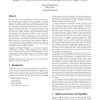SIGGRAPH
2000
ACM
14 years 6 months ago
2000
ACM
Approximating detailed models with coarse, texture-mapped meshes results in polygonal silhouettes. To eliminate this artifact, we introduce silhouette clipping, a framework for ef...
SIGGRAPH
2000
ACM
14 years 6 months ago
2000
ACM
We present a method for creating texture over an arbitrary surface mesh using an example 2D texture. The approach is to identify interesting regions (texture patches) in the 2D ex...
SIGGRAPH
2000
ACM
14 years 6 months ago
2000
ACM
Advances in 3D scanning technologies have enabled the practical creation of meshes with hundreds of millions of polygons. Traditional algorithms for display, simplification, and ...
SIGGRAPH
2000
ACM
14 years 6 months ago
2000
ACM
Physical simulation of dynamic objects has become commonplace in computer graphics because it produces highly realistic animations. In this paradigm the animator provides few phys...
SIGGRAPH
2000
ACM
14 years 6 months ago
2000
ACM
We present the WarpEngine, an architecture designed for realtime image-based rendering of natural scenes from arbitrary viewpoints. The modeling primitives are real-world images w...
SIGGRAPH
2000
ACM
14 years 6 months ago
2000
ACM
Subdivision surfaces solve numerous problems related to the geometry of character and animation models. However, unlike on parametrised surfaces there is no natural choice of text...
SIGGRAPH
2000
ACM
14 years 6 months ago
2000
ACM
SIGGRAPH
2000
ACM
14 years 6 months ago
2000
ACM
Surface elements (surfels) are a powerful paradigm to efficiently render complex geometric objects at interactive frame rates. Unlike classical surface discretizations, i.e., tri...
SIGGRAPH
2000
ACM
14 years 6 months ago
2000
ACM
We present a semi-automatic method for creating shadow mattes in cel animation. In conventional cel animation, shadows are drawn by hand, in order to provide visual cues about the...
SIGGRAPH
2000
ACM
14 years 6 months ago
2000
ACM
Named after the title, the PCCM transformation is a simple, explicit algorithm that creates large, smoothly joining bicubic Nurbs patches from a refined Catmull-Clark subdivision...

